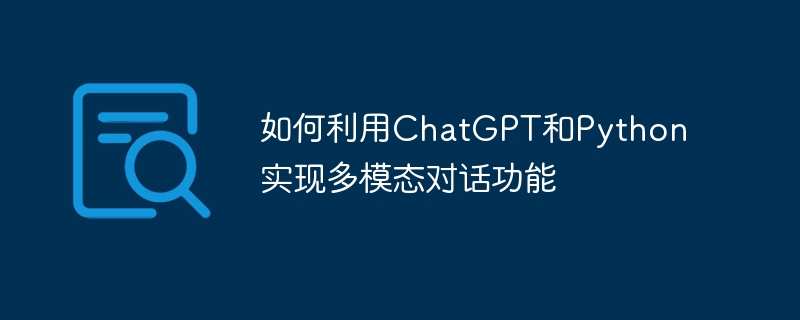Home >Backend Development >Python Tutorial >How to use ChatGPT and Python to implement multi-modal conversation function
How to use ChatGPT and Python to implement multi-modal conversation function
- 王林Original
- 2023-10-26 12:54:191091browse

How to use ChatGPT and Python to implement multi-modal dialogue function
Overview:
With the development of artificial intelligence technology, multi-modal dialogue has gradually become a research topic and application hot spots. Multimodal conversations include not only text conversations, but also communication through various media forms such as images, audio, and video. This article will introduce how to use ChatGPT and Python to implement multi-modal dialogue functions, and provide corresponding code examples.
- Preparing the ChatGPT model
First, we need to prepare the ChatGPT model. Pretrained ChatGPT models can be downloaded and loaded using Hugging Face’s transformers library. For example, the following code can be used to load the ChatGPT model:
from transformers import AutoModelForCausalLM, AutoTokenizer model_name = "microsoft/DialoGPT-medium" tokenizer = AutoTokenizer.from_pretrained(model_name) model = AutoModelForCausalLM.from_pretrained(model_name)
- Multimodal input processing
Multimodal conversations need to process different types of input, such as text, images, and audio, etc. . We can use different libraries to handle these different types of data. In this article, we will use the Pillow library to process images and the librosa library to process audio.
First, let’s take a look at how to process images. Suppose we want to pass in a picture as the input of the conversation, we can use the following code to convert the image into the input format required by the pre-trained model:
from PIL import Image
def process_image(image_path):
image = Image.open(image_path)
# 将图像转换为模型所需的输入格式
# 对于ChatGPT,一般是将图像编码为Base64格式的字符串
image_base64 = image_to_base64(image)
return image_base64For audio processing, we can use the librosa library to convert the audio file Convert to the input format required by the model. The following is a sample code:
import librosa
def process_audio(audio_path):
# 使用librosa库读取音频文件
audio, sr = librosa.load(audio_path, sr=None)
# 将音频文件转换为模型所需的输入格式
return audio.tolist()- Building a multimodal conversation
After processing various types of input data, we can use ChatGPT to conduct a multimodal conversation. Here is a basic example code that shows how to build a simple multi-modal dialogue system:
def chat(model, tokenizer, text_input, image_input, audio_input):
# 将输入数据编码为模型所需的输入格式
text_input_ids = tokenizer.encode(text_input, return_tensors="pt")
image_input_base64 = process_image(image_input)
audio_input = process_audio(audio_input)
# 将输入数据与模型所需的输入格式拼接起来
input_data = {
"input_ids": text_input_ids,
"image_input": image_input_base64,
"audio_input": audio_input
}
# 使用模型进行多模态对话
output = model.generate(**input_data, max_length=50)
# 对模型生成的输出进行解码
response = tokenizer.decode(output[0], skip_special_tokens=True)
return responseIn the above code, we first encode the text input into the model along with the image input and audio input The required input format, and then calls the model's generate method to generate the model's output. Finally, we decode the output and return the dialogue system's answer.
- Summary
This article introduces how to use ChatGPT and Python to implement multi-modal dialogue functions, and provides corresponding code examples. In practical applications, the code can be adapted and extended as needed to meet specific multimodal conversation needs. Multimodal dialogue technology has broad application prospects and can be used in a variety of scenarios such as intelligent assistants, virtual customer service, and robots. By leveraging ChatGPT and Python, we can easily build an efficient multi-modal dialogue system.
The above is the detailed content of How to use ChatGPT and Python to implement multi-modal conversation function. For more information, please follow other related articles on the PHP Chinese website!

